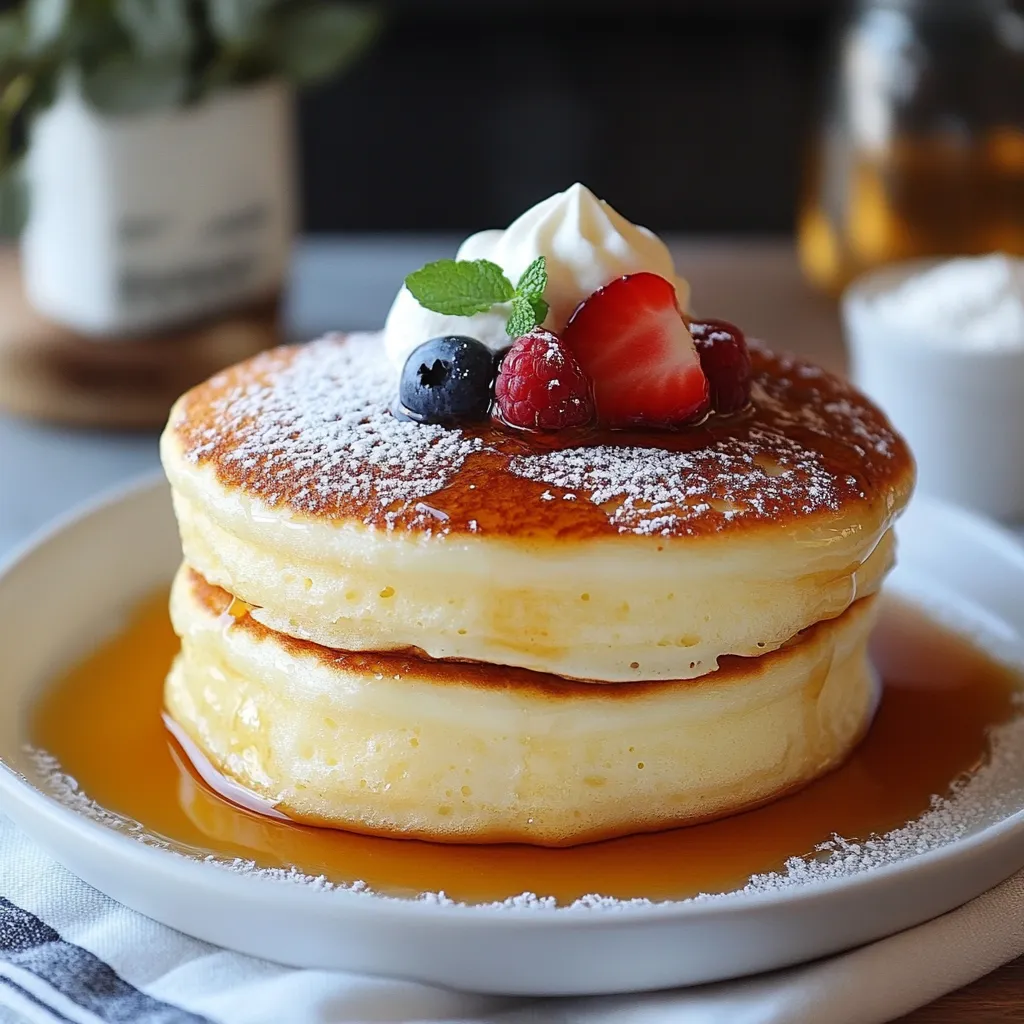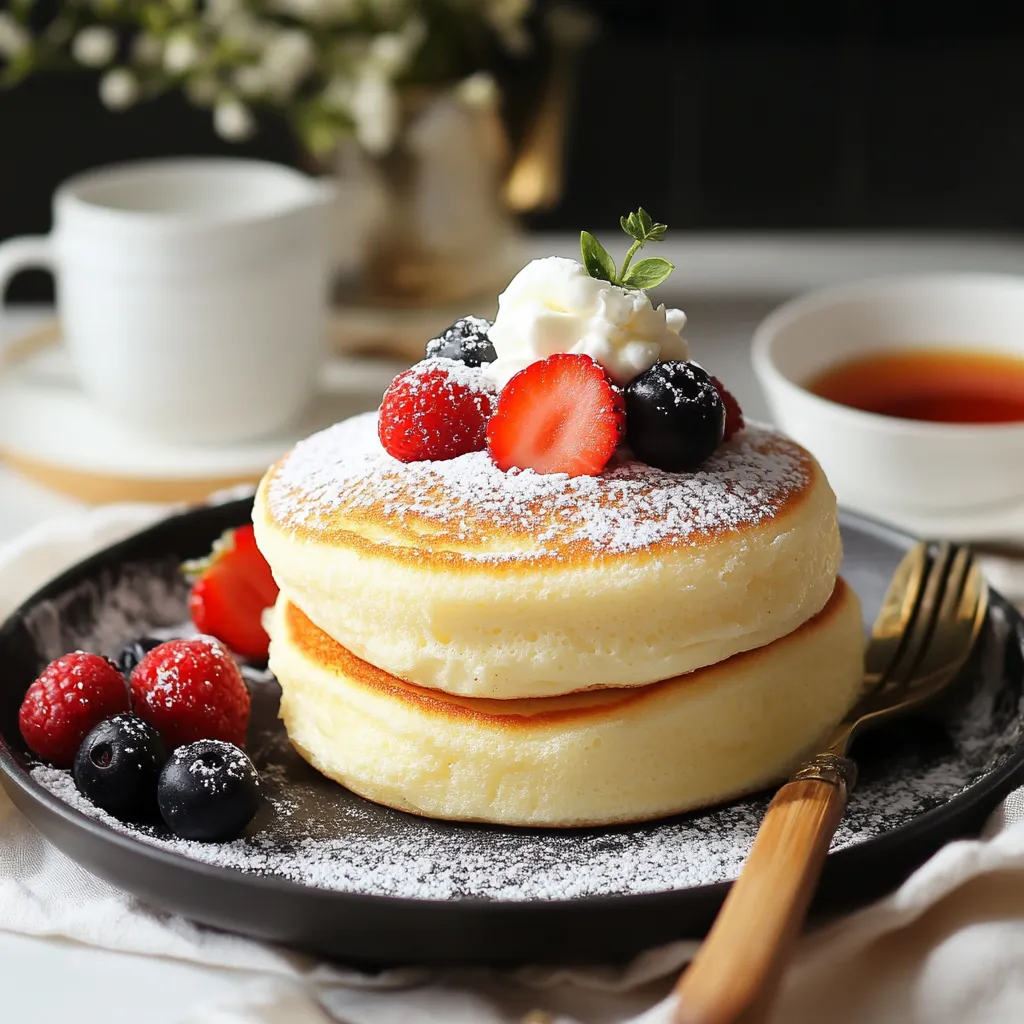 Pin it
Pin it
Japanese soufflé pancakes shine with their incredible lightness - they're like edible clouds that seem to float on the plate. When done right, these pancakes wobble slightly when served, their impressive height showing off your careful cooking and willingness to take your time. In my home, trying to get these fluffy treats just right became something I couldn't stop thinking about and taught me so much about how precise Japanese cooking can be.
I made these for friends at brunch last weekend, and everyone went quiet watching their pancakes wiggle on their plates. Even my pals who usually stay away from cooking wanted to learn how to make them after taking their first bite.
Key Ingredients and Smart Selection Advice
- Eggs: Go for fresh eggs at room temperature. If they're cold, they won't whip up as big, and older eggs can't form the right peaks. I set mine out for exactly half an hour beforehand
- Milk: Use whole milk for the richness it adds. This should also sit out until room temp so your batter stays warm enough
- Flour: Plain all-purpose flour is fine, but run it through a sifter twice to get rid of any clumps
- Sugar: Smaller sugar crystals blend better in meringue. I put regular sugar in my food processor for half a minute to make it finer
 Pin it
Pin it
Perfecting Your Meringue
The heart of soufflé pancakes is perfectly whipped egg whites. Start with a bowl that's totally clean and dry - even tiny bits of fat or yolk will ruin your meringue. Beat at medium speed until you see foam forming, then add just a tiny bit of cream of tartar or a couple lemon juice drops. This adds acidity that helps the proteins hold their shape, making your meringue more reliable.
 Pin it
Pin it
Managing Heat
Try to keep your kitchen cool and watch your ingredient temps carefully. Hot rooms make meringues droop and batters fall flat. Once your meringue is ready, work quickly - every minute increases the risk of losing air. Your pan should stay at a gentle, steady heat, around 300°F if you're checking with a thermometer.
Mixing with Care
Making the yolk mix lighter is super important. First, take about a third of your meringue and mix it into the yolk part pretty well - this first batch makes the next step easier. For the rest of the meringue, grab a big rubber spatula, cut down through the middle and scoop along the sides of the bowl. Stop as soon as you can't see white streaks anymore.
Getting the Size Right
An ice cream scoop or piping bag helps make all your pancakes the same size. Your batter should be thick enough to hold its shape but still flow a little. I pipe three circles on top of each other for each pancake to build height while keeping them stable.
Cooking Know-How
This is where you really need to wait patiently. As soon as you portion out the batter, cover your pancakes - the steam trapped under the lid helps them rise properly. Don't lift the lid for the first 4 minutes, no matter how curious you get. Look for tiny bubbles on top before you try to flip them.
My Pancake Journey
I first tried making these after having them in a tiny Tokyo coffee shop. The cook barely spoke English but showed me so much through his careful movements and focus on every detail. Each time I messed up at home taught me something new about how egg proteins work, how steam helps things rise, and why you can't rush good food.
Background and History
These pancakes show how beautifully Western cooking methods can blend with Japanese attention to detail. They started in popular Osaka cafes and have now spread worldwide, showing off how Japan takes food ideas from elsewhere and makes them even better. They really took off on social media where people couldn't get enough of watching them jiggle.
Making Them Look Amazing
Serving these pancakes is like creating art. Stack them carefully to show off how tall they are. A light sprinkle of powdered sugar makes them look snow-topped, and fresh berries add bright colors. For special times, I make a thin caramel cage around them - it's the ultimate test of managing heat just right.
Changing Up Flavors
Vanilla works great, but you can try other flavors too. Matcha powder turns them green with an earthy taste. Lemon or orange zest makes them brighter tasting, and a tiny bit of almond extract adds fancy flavor. Each change needs small adjustments to keep that perfect texture.
Fixing Common Problems
When pancakes sink down, look back at what you did: Was your meringue firm enough? Did you mix too hard? Did you keep the pan at the same heat? Every time something goes wrong, you learn important stuff about how eggs work and how heat moves around.
Tools You'll Need
You need a solid non-stick pan with a lid that fits tightly. Kitchen scales help get measurements right. Thermometers keep your heat perfect. I always have two spatulas ready - a wide one for flipping and a smaller one for shaping the edges.
Getting Ready Ahead of Time
 Pin it
Pin it
Success comes from having everything ready. Measure all ingredients carefully, prepare toppings first, and keep your workspace tidy. When you've got everything set up, you can focus completely on technique when timing matters most.
Serving at the Right Moment
These pancakes won't wait - serve them right away because they start to shrink within minutes. Warm up plates ahead of time, have all toppings ready, and make sure everyone's at the table before you start cooking. The whole experience should be as unforgettable as the taste.
Working with Your Stove
Getting to know exactly how your stove works is super important. I make a mark on my dial showing the exact spot where the heat is just right - too hot burns them, too cool stops them from rising properly. Every stove has that sweet spot for these delicate pancakes.
Bouncing Back from Mistakes
Even people who cook a lot sometimes run into trouble. If your first batch doesn't turn out great, make quick changes: maybe turn down the heat, mix more gently, or work on making your meringue more stable. Success often comes from adjusting quickly.
Closing Thoughts
Making perfect soufflé pancakes means understanding how everything works together. Everything matters - from how stable your whipped egg whites are to how hot your pan is - in getting that famous wiggle. After trying many times in my kitchen, I've found that success isn't just about following steps but developing a feel for the process.
Frequently Asked Questions
- → Can I prep the batter beforehand?
- You’ll want to whip up and cook the batter immediately, as letting it sit deflates the meringue.
- → Can I swap out the flour?
- Using all-purpose flour is ideal, but a gluten-free blend can work if needed.
- → Is there a vegan-friendly option?
- You can try aquafaba or a vegan egg replacer to mimic the meringue effect.
- → How can I stop them from flattening?
- Fold the meringue gently to avoid breaking the air bubbles. Also, cook slowly and keep the lid on.
- → Can I save and eat these later?
- They’re best fresh, as they lose that fluffy texture over time.
